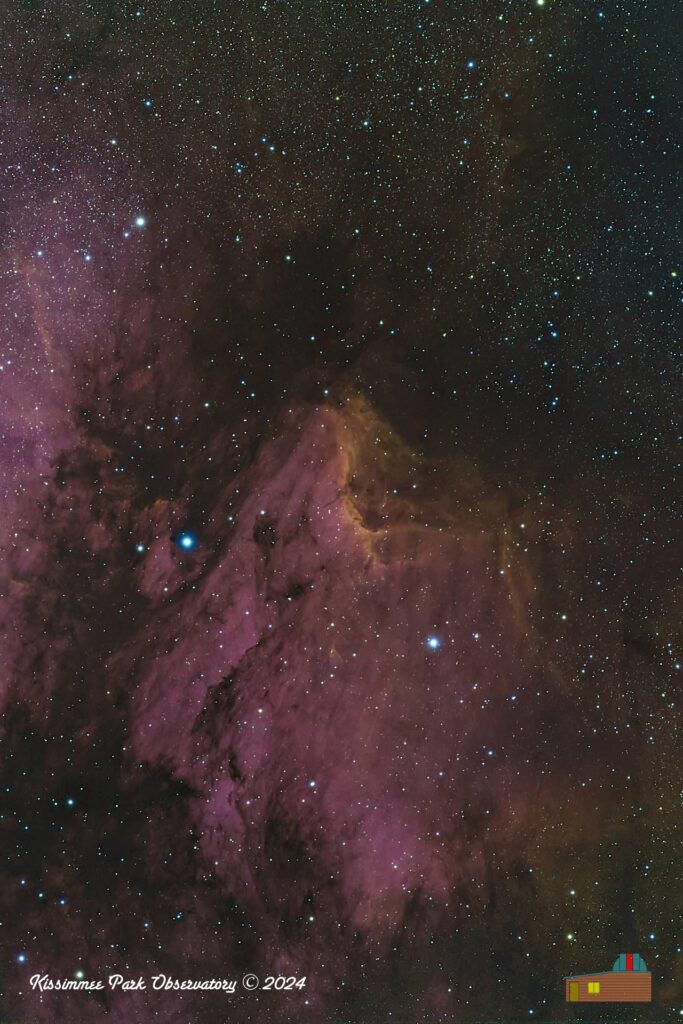
The Pelican Nebula (IC 5070) in Cygnus, captured by the WFAC from Big Bend National Park (Bortle 1). HSO image with a total integration time of 3.8 hours.
Introduction to the Pelican Nebula
The Pelican Nebula, designated IC 5070, is a prominent emission nebula located in the constellation Cygnus. It is adjacent to the North American Nebula (NGC 7000) complex, a region renowned for its vigorous star formation activity. The nebula is named for its resemblance to a pelican, a feature most evident in detailed astronomical images.
Structure and Composition
The Pelican Nebula is a vast cloud of ionized gas and interstellar dust. The nebula’s primary component is hydrogen, which is ionized by the ultraviolet radiation emitted by nearby young, hot stars. This ionization process causes the nebula to glow, making it a classic example of an emission nebula.
Key features of the nebula include:
- Emission Regions: These are areas where the gas is ionized by the radiation from young stars, resulting in bright, colorful emissions.
- Dark Dust Lanes: These lanes are regions of dense dust that obscure parts of the nebula. The dust creates intricate patterns and adds texture to the nebula’s appearance.
Star Formation
The Pelican Nebula is a stellar nursery, an environment where new stars are continually forming. The process begins when dense regions within the nebula collapse under gravity to form protostars. As these protostars develop, they eventually become hot, massive stars that further ionize the surrounding gas.
The nebula is particularly notable for:
- Young, Massive Stars: These stars emit strong stellar winds and ultraviolet radiation, which contribute to the ionization of the gas in the nebula.
- Triggered Star Formation: The intense radiation and stellar winds from these young stars can compress nearby gas clouds, leading to further star formation within the nebula.
Observing the Pelican Nebula
For amateur astronomers, the Pelican Nebula is observable with the aid of a large telescope. Although it is not visible to the naked eye, telescopic views reveal some details in a dark sky. Advanced telescopes and astrophotography techniques can capture high-resolution images of the nebula, as above, showcasing its complex structure and vibrant hues.
Significance in Astronomy
The study of the Pelican Nebula provides valuable insights into the processes of star formation and the structure of interstellar space. By analyzing the nebula, astronomers can learn about:
- Star Formation Mechanics: Understanding how new stars form and evolve within such nebulae.
- Interstellar Medium: Gaining insights into the composition and behavior of the gas and dust that make up the nebula.
Conclusion
The Pelican Nebula (IC 5070) serves as a compelling example of the dynamic and evolving nature of the cosmos. Its vibrant emission regions and intricate dust structures make it a significant object of study in the field of astrophysics. Whether through observational astronomy or scientific research, the Pelican Nebula continues to enhance our understanding of star formation and the broader universe.
Tap on the image above to view a larger version you can explore.
Image Info
- Imaged from Big Bend National Park (Bortle 1)
- Camera : ZWO ASI1600MM Pro
- Scope: Askar 400 Quintuplet Astrograph f/5.6
- Mount: iOptron Smart-EQ Pro
- Hydrogen Alpha: 17 subframes of 300s = 85 min integration
- Oxygen III: 16 subframes of 300s = 80 min integration
- Sulfur: 13 subframes of 300s = 65 min integration
- Total integration time: 230 min = 3.8 hours.
- Captured via ASIAir Pro automation
- Optical tracking via ASIAir automation via the ASI174mm Pro guide camera
- Separate channels stacked and HaGB integrated in Astro Pixel Processor
- Image run through Super DeNoising
- Final processing in Aperture
